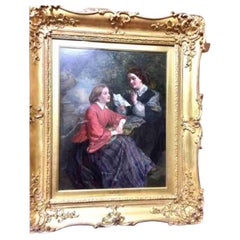John Faed
Recent Sales
Oil Painting of Two Ladies Discussing Letter 'John Faed'
By Thomas Faed
Located in Antrim, GB
Beautiful oil painting of two ladies discussing letter (John Faed)
Gilt Swept Frame titled The
Category
Antique 19th Century Scottish Victorian Paintings
Materials
Paint
Shakespeare and his Contemporaries
By John Faed
Located in New Orleans, LA
1851, the year Faed was made a Royal Scottish Academician (or elected to full membership). It proved
Category
Mid-19th Century Interior Paintings
Materials
Oil
Thomas Faed Painting
Located in Hamilton, Ontario
was born on 8 June 1826, in Gatehouse of Fleet, Kirkcudbrightshire, and was the brother of John Faed
Category
Antique 19th Century Scottish Paintings
George Washington Receiving a Salute on the Field at Trenton- Hand-Colored Print
Located in Colorado Springs, CO
engraved by William Holl (1807-1871) after the painting by John Faed. It was published circa 1860 by the
Category
Antique 1860s Historical Memorabilia
H 40 in W 32 in D 3 in
"Washington Receiving a Salute on the Field of Trenton" William Holl, circa 1860
Located in Colorado Springs, CO
This striking print was engraved by William Holl (1807-1871) after the painting by John Faed. It
Category
Antique Mid-19th Century American Prints
H 40.5 in W 32.5 in D 2 in
Antique 19th century portrait of a seated dog Pepper, in a landscape
By John Frederick Herring Sr.
Located in Woodbury, CT
, G. B. Campion, John Faed, W. P. Frith—to produce paintings in which he portrayed the animals and the
Category
1830s Victorian Animal Paintings
Materials
Canvas, Oil
Antique 19th century English portrait of an Irish Hunter in a stable
By John Frederick Herring Sr.
Located in Woodbury, CT
, G. B. Campion, John Faed, W. P. Frith—to produce paintings in which he portrayed the animals and the
Category
1840s Victorian Animal Paintings
Materials
Canvas, Oil
Thomas Faed Painting, Oil on Canvas, 19th Century
By Thomas Faed
Located in Hamilton, Ontario
, Kirkcudbrightshire, and was the brother of John Faed.
He received his art education in the school of design
Category
Antique 19th Century Scottish Paintings
Sir Joshua Reynolds Visiting Goldsmith in Study- Exhibited British Victorian art
By John Faed
Located in London, GB
John Faed RSA. It was exhibited at the Royal Academy in 1877 and the details along with more provenance
Category
19th Century Realist Portrait Paintings
Materials
Oil
Hunter with his Dog in a Landscape - Scottish Victorian art oil painting Cadzow
Located in London, GB
have been influenced by artists like Peter Graham, a friend of Thomas Faed, and John MacWhirter who he
Category
19th Century Realist Landscape Paintings
Materials
Oil
Antique 19th century English portrait two Bull Dogs in a yard.
By John Frederick Herring Sr.
Located in Woodbury, CT
, John Faed, W. P. Frith—to produce paintings in which he portrayed the animals and the others the
Category
1840s Victorian Animal Paintings
Materials
Canvas, Oil
Get Updated with New Arrivals
Save "John Faed", and we’ll notify you when there are new listings in this category.

